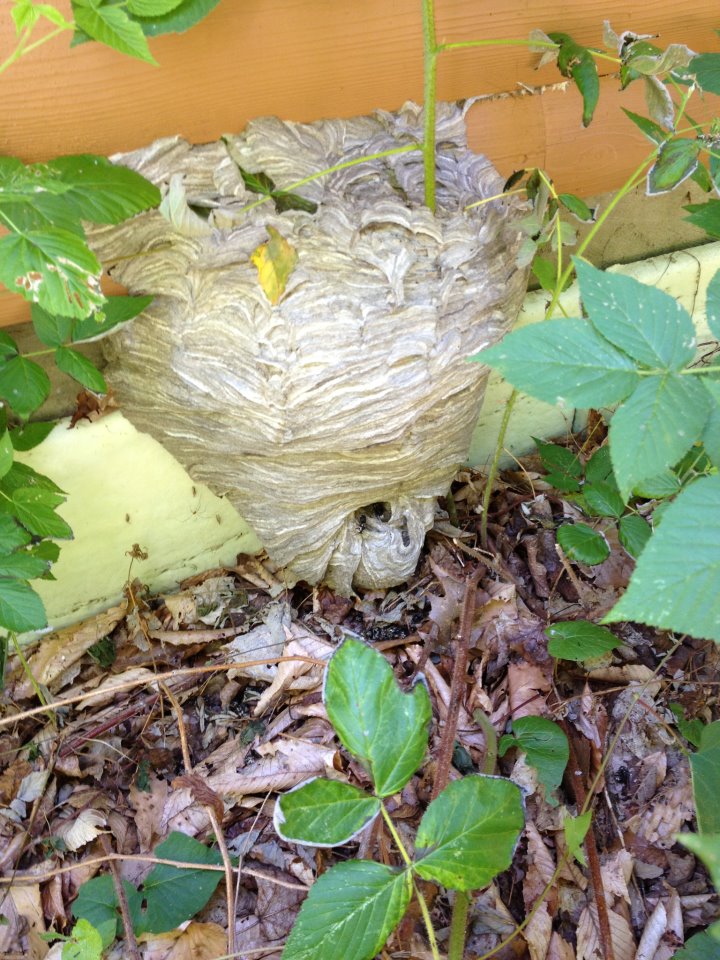More closely related to the yellowjacket wasp than actual hornets, bald-faced hornets get their name from their mostly black bodies and stark white faces. They classify as hornets rather than wasps because of their size and aerial nests. Queen bald-faced hornets are larger than their adult-worker counterparts. Bald-faced hornets are social insects, although they are not true hornets. They are most noticeably active during the day and live in colonies that may contain between 100 and 400 members at their largest.
They construct their nests of a grey, paper-like substance; these nests are enclosed, unlike the cone-shaped structures of other stinging hornets and insects, such as yellowjackets and paper wasps. These nests will be at least three or more feet off of the ground and are most commonly found in bushes, trees, utility poles, on overhangs, sheds, and houses. The nests can reach up to 14 inches in diameter and more than 24 inches long!
Dangers of Bald-faced Hornets
The stings of bald-faced hornets are venomous and painful, and the sites may swell and itch up to one full day. Because of this, humans run the risk of allergic reactions from bald-faced hornet stings as with other insect stings. These are aggressive insects that will attack anything that invades their space; making them quite unlike other stinging insects that typically only sting when they feel exceptionally threatened. These factors make the removal, which you should always leave to a professional for safety purposes, somewhat tricky. Their stingers are short and smooth, so they can sting repeatedly; whereas other stinging insects with barbed stingers, such as honeybees, are only able to attack once before their stinger physically rips off.
Homeowners will begin to notice bald-faced hornets in late summer when the populations are at their largest. Males hatch from unfertilized eggs to impregnate the new females for the next year’s season in the late summer months. The inseminated hornets are the only ones that overwinter when the temperatures cool, while the remaining, uninseminated members die off. In the following spring and summer, the process repeats. Unlike other nest-building insects, bald-faced hornets do not reuse their nests year after year—the new members will rebuild them each year using fresh materials.
How To Avoid An Attack
Avoiding contact with these insects at all costs is key to preventing the painful attacks. Homeowners should seal up any tiny holes or cracks where bald-faced hornets are able to enter when seeking shelter. In addition, keeping food covered at all times, especially when outdoors, will help keep the hornets at bay. When spending time outdoors, you should avoid wearing strong perfumes or products with fragrances and opt for unscented products instead. Likewise, you should wear footwear that covers and protects feet from rogue hornets.
If you find what you assume to be a bald-faced hornet nest on your home or property, it is imperative that you do NOT make any attempt to remove it on your own. This can aggravate the colony, which will cause the hornets to attack and sting. Contacting a licensed pest control professional about proper hornet removal to avoid the risk of bald-faced hornet stings is the safest and most effective method.
Unfortunately for bald-faced hornets, they do not serve any real purpose like the honey bee; also, they do not pollinate plants. Hogarth’s Pest Control and Wildlife Removal can effectively and efficiently remove these types of hives from your property. Please give us a call if you happen to find one of these nests throughout the summer.
 Bees, wasps, yellow jackets and hornets are one of the most common pest control issues we deal with at Hogarth’s Pest Control. Stinging insects are often unwelcome summer guests, nesting on homes, in trees, under decks and even underground. Though all stinging insects have multiple similarities, each have individual qualities that differentiate them.
Bees, wasps, yellow jackets and hornets are one of the most common pest control issues we deal with at Hogarth’s Pest Control. Stinging insects are often unwelcome summer guests, nesting on homes, in trees, under decks and even underground. Though all stinging insects have multiple similarities, each have individual qualities that differentiate them.